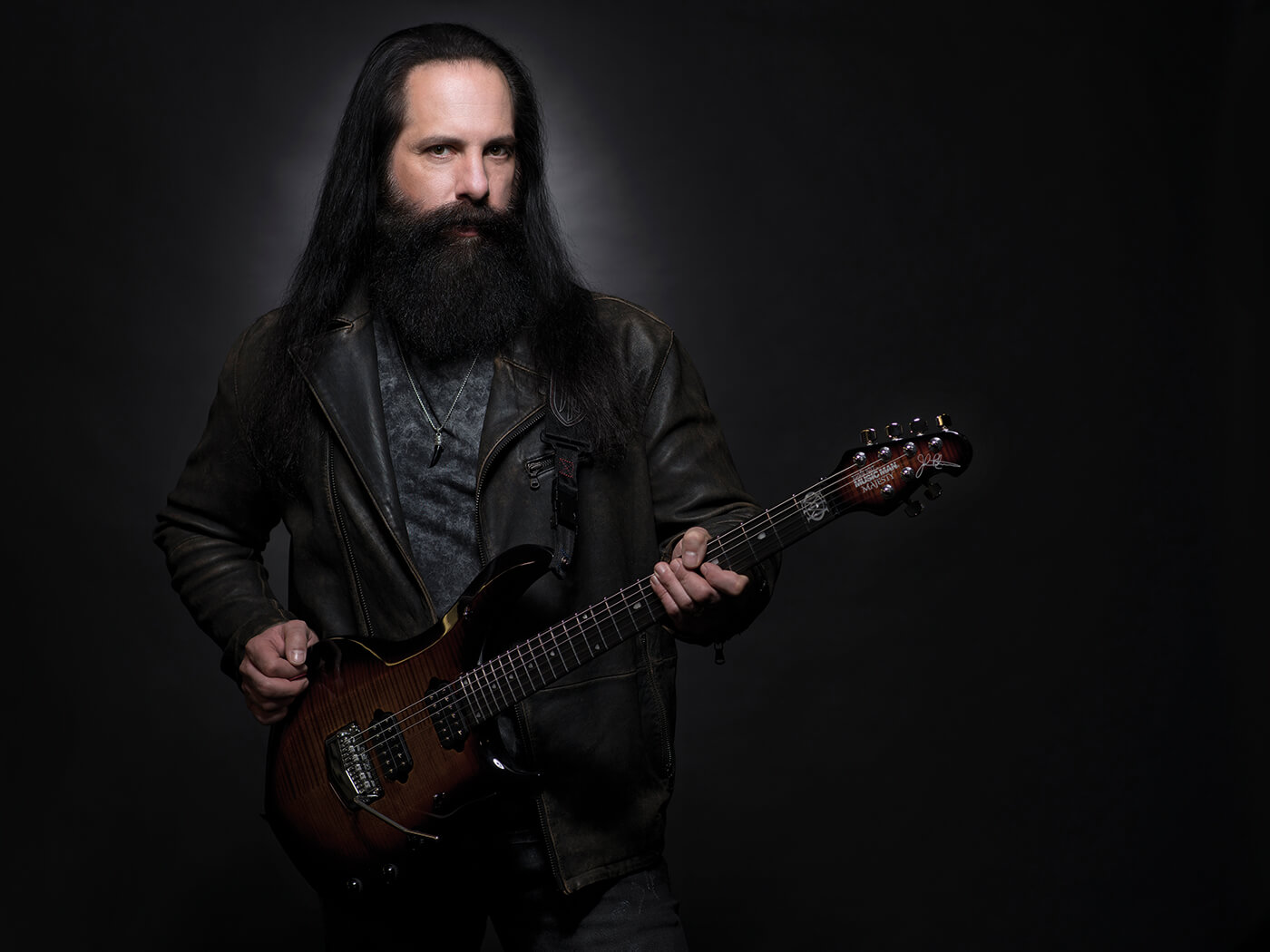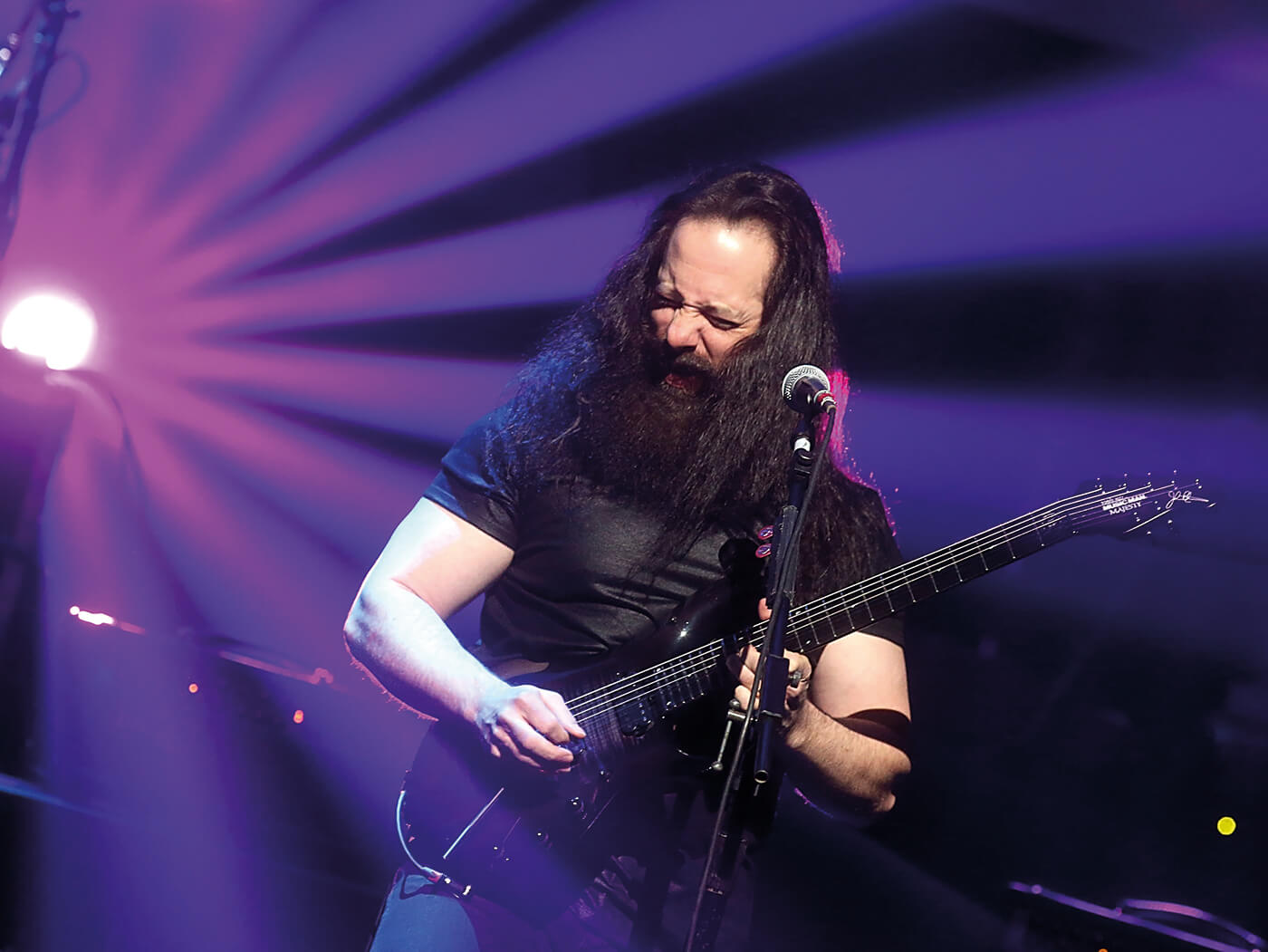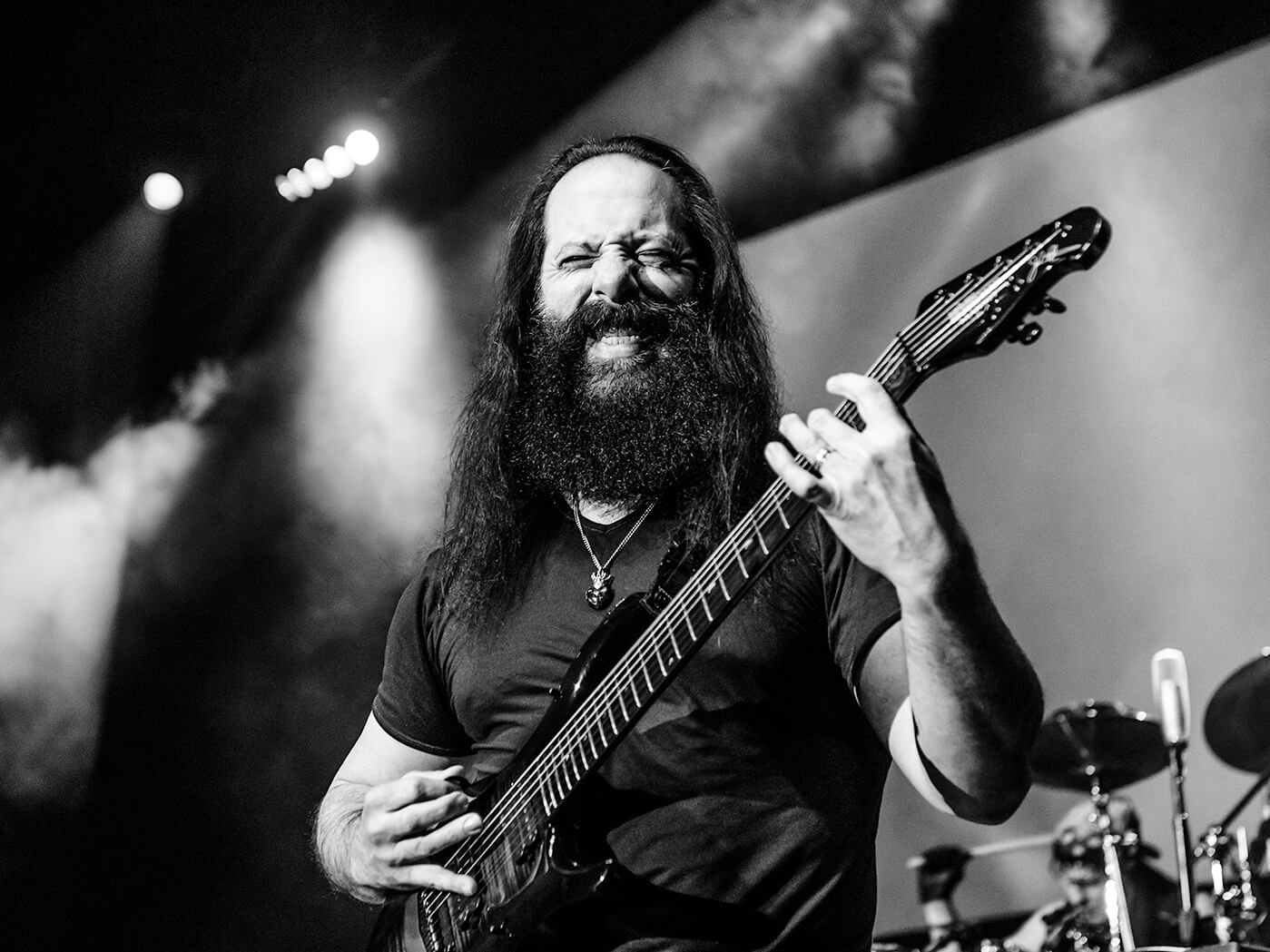Interview: John Petrucci on Dream Theater’s new album, Distance Over Time
On the verge of 14th album Distance Over Time, the spectacularly talented guitarist sees Dream Theater celebrate their 30th anniversary with two Grammy Award nominations and millions of album sales to their name. We sit down with Petrucci about the blues, signature gear and why Joe Satriani still amazes him.

For a band that’s been together for over three decades with an album catalogue in double figures, it must surely be difficult to remain innovative and fresh while continuing to be a genre-defining force. But for the undisputed kings of progressive metal, the studio sessions for new record Distance Over Time necessitated a new direction.
The band locked themselves away at a secluded facility in New York to create and write an album that reflected and captured how they think they sound best – jamming in a room together, with their amplifiers cranked up. Happily, they succeeded.
Recent forays into huge orchestral arrangements and reverb-laden electronica have been eschewed in favour of a more stripped-down approach, often referencing the classic-rock touchstones of Deep Purple and Free, and showcasing a rawness and authenticity – perhaps even vulnerability – hitherto unheard on a Dream Theater album.
Of course, the performances from all five musicians are still technically astounding (this is Dream Theater, after all), but as far as songwriting goes, the new album is possibly more representative of Dream Theater ‘the band’, thanks to the collaborative approach to writing that shutting yourself away from to the rest of the world affords.
We sat down with John Petrucci to discuss his new approach to songwriting, going back to his blues and classic-rock roots and why he doesn’t feel the need to experiment with gear any more…

You locked yourselves away to write and record this album. How did that change your approach?
“In some ways, it really didn’t change the type of interaction that we normally have when we write together. I guess what it did change was that the overall atmosphere was way more relaxed: we weren’t really on a time schedule and we were able to have a bit more free time to talk about the music, hang out, eat and bond. The settings just kind of
made that interaction and that chemistry, that’s already really good, a little more relaxed and flowing.”
Did you all have all songs written before, or was the majority of the material written in the studio?
“The majority of it is written in the studio together. I felt it was really important this time to have everybody’s involvement and have it be a very collective experience. But we also don’t go in empty handed: we have a whole bunch of ideas from soundcheck that happened while we were on tour, and then I have ideas, guitar riffs and chord progressions, melodies and things that I’ve collected.”
Did you have an idea of what type of album you wanted to create from the outset?
“Before we went in – we had talked about it a lot, actually – we really wanted this album to be more of the ‘primal’ Dream Theater. When we get together and we play and the amps are cranked up in a room, we just lock into these really strong, aggressive grooves. It’s a lot of fun; the type of thing that puts smiles on our faces.
“We wanted to make sure on this record that we kind of showcase that and feature that heavier, groovier side. We also talked about having a lot of playing, a lot of freedom as far as solos and trades, instrumental parts and things just to kind of infuse that part of our sound I think is really important.
“We talked about as well the length of the album, keeping it a bit shorter, keeping it around an hour, keeping the songs more concise – so that you could potentially, in one sitting, in a car ride or something like that – listen to the whole album.”

How do you approach writing instrumental interludes? Like for example, the one that features in Pale Blue Dot?
“First of all, going into it, we knew that we wanted it to be kind of wacky and crazy and very angular. So that means when we’re putting ideas together it’s not like normal songwriting; they don’t necessarily have to be coming from the same headspace: they could be completely different feels, time signatures, tempos. We’re going into it saying ‘anything goes’, and we wanted it to be really like a pinball in a pinball machine, just bouncing from one section to the next, so that as a listener you can’t really anticipate what’s going to happen.
“The larger challenge is you have all these different sections that are in different time signatures, keys, feels – how do you make them connect in such a way that it works? A lot of that’s done with resolution, as far as key changes and voice leading is concerned – we use a lot of voice-leading techniques. Some of those connections are made through melodies where the melody is the glue, and some of the things where we’re connecting from one section to the next are done rhythmically.”
What was your approach to solos on this album? Were they improvised?
“Some of the themes for the solos sort of happened while writing the album. So, for example, the whole outro section of At Wit’s End fades out with the guitar doing a melody part. That melody I came up with while we were writing the song; it’s on the demos.
So I wanted to make sure that I retained that melody, because it really worked, musically.
“The solo in Out Of Reach, which is a baritone guitar, a lot of that I recorded just on the floor in front of my amp. It’s very, very close to the live improvised demo version I did, because I thought it had a really cool feel to it. The other ones are more complicated,
I guess; more involved.
“It’s a combination of improvising and going for some sort of feel, but also having an idea: like for this section, I really want to do this crazy, crazy run, but I’m not sure what the notes should actually be, so then I’ll work out what the notes should be and work it in. It’s a combination of composing, a bit of improvising and a bit of drawing from what I did when we first wrote the song.”
When you listen back to a lead take that you’ve recorded, are you happy to prioritise feel over technical perfection?
“Yeah, definitely. It’s something that took me a while to be able to let go of. Sometimes, it’s just something that happens that was magical the first time and it’s like, yeah, you might be able to play it a little bit better, but you captured something. It’s like lightning
in a bottle, and you don’t want to get rid of that flavour trying to get the perfect version.��” For this album, you said that you wanted to go back to your roots in metal and prog. But listening to it, we detect quite a lot of classic-rock flavours; are those bands and those genres influences?
“Absolutely. Some of those more bluesey, sort of Zeppelin-y things were coming out – and some Deep Purple and Metallica. Things like that, once you start to kind of do blues-based riffs, it’s going to evoke that kind of mood. Also, the other thing is that Jordan is purposely using a lot less electronic sounds and a lot more organ, and distorted organ.
“I really wanted this album to sound like the guys playing. Everybody is a very strong musician when it comes to playing the song together. Forget any bells and whistles and things like that: what does this sound like when we’re all jamming and rocking out? It’s actually a very powerful and groovy sound.”
Did you use your Mesa/Boogie JP-2C signature amp throughout the album, or did you experiment with any other amps?
“I have no need to experiment any more, my signature Boogie is like my dream amp. It’s exactly what I need; it does everything that I’m looking for perfectly.” Did you experiment with any other guitars in the studio, or did you just use your Music Man signature models throughout?
“Again, no reason or desire to reach for anything else. I’ve been with Music Man for 18 years now and my signature line, to me, are the best guitars on the planet. I had a whole bunch of Majestys with me in the studio, with various different tunings, so the record is all Majesty – except for two songs, where I used my signature baritone version.”

What do you think your strengths and weaknesses are as a guitar player?
“I think my strengths are I’m able to make the guitar do what I’m imagining I want it to do. Since I was young, I’ve always worked on my technique to get it to the point where if there was something I’ve heard in my head, then I was able to do it. As far as weaknesses, there are so many aspects of guitar playing, so many different styles that I’m very much not connected to, not good at, don’t have experience with.
“Some of the greatest players, like Joe [Satriani], or like a Guthrie Govan, have the ability to bust out everything from Travis picking to gypsy jazz, bluegrass, blow through the giant step changes and things. Even though I went to Berklee and all that, it’s just like those types of things are all difficult to master in themselves. If anything, I’ll hear a player like Joe play and start drawing from all these different influences, and I’m kinda like scratching my head, like: ‘Hey, wait a minute, how do you do that?’”
Did you benefit as a guitarist and musician by having to learn and transcribe in the way you did, rather than having the information at your fingertips, as it is these days?
“I’m not really sure. Now, kids can see it and watch it on YouTube and slow it down and see exactly how it’s being done: we didn’t have that, I didn’t have that. I had to, like, drop a needle on a record if I wanted to learn an Al Di Meola lick. Even Jimmy Page licks,
I had no idea how they were doing it, and you’d try to imagine how they were doing it and that took longer. So maybe there’s some benefit from that kind of struggle and hard work, figuring it out on your own.”
Do you still practise and study these days?
“Absolutely. Recently, I actually went to a small luthier in Germany who’s got a gypsy-jazz acoustic that I’ve started getting into. I was really blown away by the unbelievable technique and improvisational skills of those guys and I was listening to that and I was like: ‘I want to be able to do that.’ Yeah, that happens all the time, for sure.”
You’ve got a unique approach in that in a lot of your solos, you tend to pick every note, which gives an aggressive feel to the line; what is it about picking every note that appeals to you musically?
“When I first got into that by listening to Steve Morse and Al Di Meola, I was really, really addicted to that whole concept, and was like: ‘I’m going to pick every note and that’s the only way to be,’ because it creates a very loud, forward, powerful and articulate sound when you’re playing. It’s the articulation and the separation of the notes – if you do it right, there’s nothing like that. There’s also this challenge and this pride, and kind of bragging rights that you can play in such a way that’s harder. It’s like you’re taking the more difficult path, so you’re able to have this pride.
“As the years have gone by and I’ve done more and more playing, recording and touring, I tend to use picking every note as a variation in my technique. So I’ve kind of come to the point where I do way more of a combination of a whole bunch of different techniques, instead of just using one.”
Dream Theater’s new album, Distance Over Time, is out now on Inside Out.
